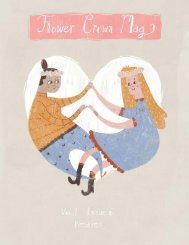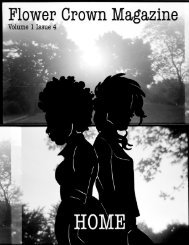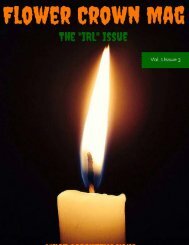Flower Crown Magazine: Issue 2
The Celebrity Skin Issue flowercrownmag.com
The Celebrity Skin Issue
flowercrownmag.com
Create successful ePaper yourself
Turn your PDF publications into a flip-book with our unique Google optimized e-Paper software.
Where Are All the Disabled Women?<br />
By Katrina Vargas<br />
Nobody can really applaud the representation of<br />
women in mass media; if we are actually ever shown, it’s<br />
usually as the supporting side character for an aloof, ill<br />
qualified, generically attractive man who fumbles through<br />
life under our care, as the public laughs along while we<br />
roll our eyes and wonder just what we’re going to do with<br />
this rascal. These women are almost always seen, and filed<br />
under, the non-threatening “norm”: white, heterosexual,<br />
cisgender, well-educated, upwardly mobile women whose<br />
lives fill only the blank spaces that need a little noise; women<br />
who don’t take up much room, don’t feel their bodies<br />
failing them, don’t overlap into<br />
spaces they’re supposed to be<br />
hidden away from; these women<br />
never feel lost in, or denied entrance<br />
to, a society that makes<br />
clear they’re not welcome. Oh,<br />
and one thing I forgot to mention<br />
about these women that<br />
would otherwise throw a wrench<br />
into the lives of all these characters?<br />
None of them are disabled.<br />
This sounds nearly<br />
impossible. No disabled<br />
characters? That can’t be. It’s<br />
true, if you run through some<br />
characters in your mind, you’ll<br />
eventually land on a few pretty<br />
significant characters who are disabled; Tyrion Lannister<br />
from Game of Thrones, Walter White, Jr. from Breaking<br />
Bad, Professor Xavier from X-Men - even Hiccup from<br />
How to Train Your Dragon. Listen, I think these characters<br />
are wonderful. I love that they’re all complex people who<br />
are each shown to have their own lives, who aren’t simply<br />
there for the consumption of abled viewers. I love it, I do.<br />
But, these men all fall into the same illusory representation<br />
that these women do, of an ideal reserved for only<br />
so many people; an ideal that doesn’t represent the rich<br />
diversity of the people they’re portraying, falling flat on<br />
the issues surrounding disabled people - who are, by and<br />
large, in poverty, and as such, are often women, people of<br />
color, and members of the LGBTQIAP+ community<br />
(and just forget representation at all if you fall into more<br />
than one of these identities). In the media’s slapdash representation<br />
of marginalized people, disabled characters are<br />
simply a decorated copy of the normalization of people in<br />
power.<br />
Image by Ellen Havasy<br />
So, what do we do with disabled women? How<br />
do we treat them? How do we understand women who<br />
take up space - or who don’t fall into the small corner of<br />
normalized beauty and ability? It’s quite a daunting question.<br />
Perhaps, then, we should start looking at it as “Why?”<br />
rather than “How?”, then. Why are we not seeing disabled<br />
women? Why do we hide disabled women away, rather<br />
than celebrate them? Why do we refuse to tell disabled<br />
women’s stories?<br />
I, alone, of course, cannot answer that any more<br />
than I could answer the silencing of so many other women.<br />
I can only tell you that disabled<br />
women - all disabled women -<br />
deserve to see themselves and<br />
have their stories told. I want to<br />
see media bring attention to the<br />
injustices disabled women face,<br />
especially when their identities<br />
intersect with different systems<br />
of oppression. I want to see the<br />
stories of autistic black girls, who<br />
are often diagnosed years after<br />
white children - or are misdiagnosed<br />
entirely. I want to see the<br />
stories of transgender women<br />
in wheelchairs who struggle to<br />
find housing due to lawful ability<br />
to deny them a home because<br />
of their gender, and absence of accessibility throughout<br />
society.<br />
I want to see the stories of older, deaf bisexual<br />
women who only learn to sign later in life, because of oralism’s<br />
prevalence in her adolescence, excitedly learning the<br />
sign for ‘bisexual’ for the first time. I want to see the stories<br />
of intellectually disabled indigenous girls who struggle<br />
for their reproductive rights, as both an indigenous and<br />
disabled person, and the ability to sterilize them against<br />
their will, at as young as five years of age. I want disabled<br />
women and girls to see themselves, to know themselves<br />
and love who they are.<br />
Write about us. Write about us as you would abled<br />
women and girls. Write about us as our own people, good<br />
and bad, not as a tale of inspiration, or a learning experience<br />
for abled characters and the abled audience. Listen<br />
to us. Think about us. It’s time we came out of your shadows.







